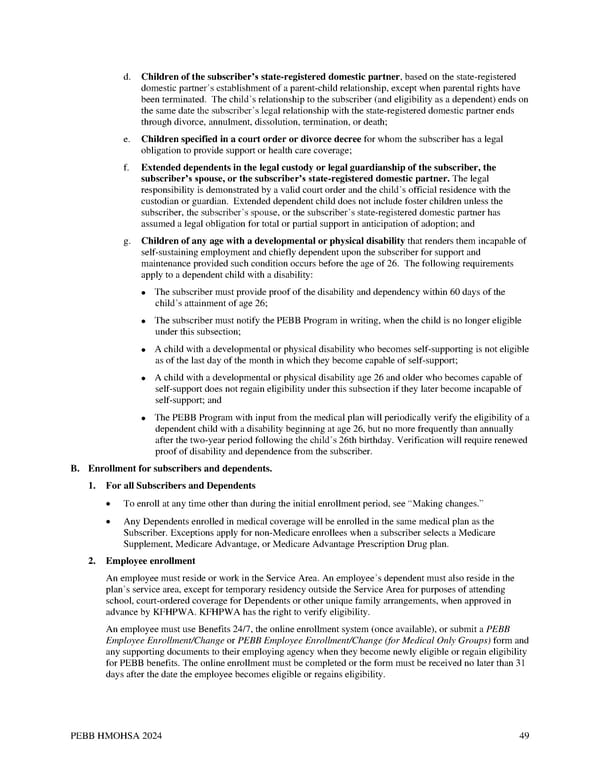d. Children of the subscriber’s state-registered domestic partner, based on the state-registered domestic partner’s establishment of a parent-child relationship, except when parental rights have been terminated. The child’s relationship to the subscriber (and eligibility as a dependent) ends on the same date the subscriber’s legal relationship with the state-registered domestic partner ends through divorce, annulment, dissolution, termination, or death; e. Children specified in a court order or divorce decree for whom the subscriber has a legal obligation to provide support or health care coverage; f. Extended dependents in the legal custody or legal guardianship of the subscriber, the subscriber’s spouse, or the subscriber’s state-registered domestic partner. The legal responsibility is demonstrated by a valid court order and the child’s official residence with the custodian or guardian. Extended dependent child does not include foster children unless the subscriber, the subscriber’s spouse, or the subscriber’s state-registered domestic partner has assumed a legal obligation for total or partial support in anticipation of adoption; and g. Children of any age with a developmental or physical disability that renders them incapable of self-sustaining employment and chiefly dependent upon the subscriber for support and maintenance provided such condition occurs before the age of 26. The following requirements apply to a dependent child with a disability: The subscriber must provide proof of the disability and dependency within 60 days of the • child’s attainment of age 26; The subscriber must notify the PEBB Program in writing, when the child is no longer eligible • under this subsection; A child with a developmental or physical disability who becomes self-supporting is not eligible • as of the last day of the month in which they become capable of self-support; A child with a developmental or physical disability age 26 and older who becomes capable of • self-support does not regain eligibility under this subsection if they later become incapable of self-support; and The PEBB Program with input from the medical plan will periodically verify the eligibility of a • dependent child with a disability beginning at age 26, but no more frequently than annually after the two-year period following the child’s 26th birthday. Verification will require renewed proof of disability and dependence from the subscriber. B. Enrollment for subscribers and dependents. 1. For all Subscribers and Dependents • To enroll at any time other than during the initial enrollment period, see “Making changes.” • Any Dependents enrolled in medical coverage will be enrolled in the same medical plan as the Subscriber. Exceptions apply for non-Medicare enrollees when a subscriber selects a Medicare Supplement, Medicare Advantage, or Medicare Advantage Prescription Drug plan. 2. Employee enrollment An employee must reside or work in the Service Area. An employee’s dependent must also reside in the plan’s service area, except for temporary residency outside the Service Area for purposes of attending school, court-ordered coverage for Dependents or other unique family arrangements, when approved in advance by KFHPWA. KFHPWA has the right to verify eligibility. An employee must use Benefits 24/7, the online enrollment system (once available), or submit a PEBB Employee Enrollment/Change or PEBB Employee Enrollment/Change (for Medical Only Groups) form and any supporting documents to their employing agency when they become newly eligible or regain eligibility for PEBB benefits. The online enrollment must be completed or the form must be received no later than 31 days after the date the employee becomes eligible or regains eligibility. PEBB HMOHSA 2024 49
 Kaiser Permanente WA CDHP EOC (2024) Page 48 Page 50
Kaiser Permanente WA CDHP EOC (2024) Page 48 Page 50